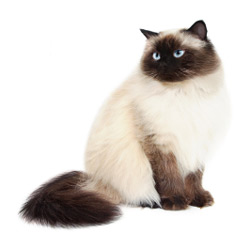|
The Scratching Post
Himalayan

The Himalayan is also known as the Color Point Persian and is listed as the second most popular breed of cat. The Himmie is a medium to large breed with short, thick legs and a heavy-boned body. The head is massive and round which sits on a short and thick neck. There are two different facial types: the Extreme and the Traditional (aka the Original). The eyes of this breed are large, round and set far apart. The eye color is a vivid eye-catching blue. The nose is short, snub and broad. The small ears are round at the tip, set far apart and low on the head. The thick tail is proportioned to the body. The Himalayan has the distinguishing color points of a Siamese. The Himmie is solid with an overall appearance of roundness.
|
|
Temperament
|
The Himalayan is one of the most popular of all Persians. This regal breed is a sedate and affectionate cat. They prefer to cuddle with you rather than climb up your favorite curtains. This breed is very responsive to your moods, sharing your joys and bearing your sorrows. Some breeders say that the Himmie is a talkative breed; however, they have soft, pleasant voices. They are sweet, gentle, loyal and are good with children and other animals. This playful breed will not just sit around like the Persian. They love attention, and are full of personality. They love to lie in your lap if you are sitting down and sleep on your pillow at night. Becoming a member of the Himalayan club requires you to become a cat hair stylist.
|
|
Height, Weight
|
Male: 9-14 lbs. ; Female: 7-11 lbs.
|
|
Health Problems
|
Because of the large and protruding eyes, they are prone to eye infections, injuries and irritations. As with flat-nose breeds, they tend to have breathing problems and excessive eye tearing. This breed is also prone to polycystic kidney disease (PKD), gingivitis and hairballs.
|
|
Living Conditions
|
Himalayans are not suited for outdoor life. Their long coats are susceptible to tangles and gathering prickly plants, ticks or other parasites. Indoor cats are generally healthier and live longer than their outdoor counterparts. Fulfill your cat?s jungle dreams by giving them plenty of playtime, leafy plants for their hide-and-pounce pleasure and regular visits to the screened window or screened porch for fresh air and a scent of the wild. This breed may also be sensitive to overly warm weather because of their coat. Do not leave them in a home without air conditioning during the hot summer months.
|
|
Exercise
|
This breed is active and gets plenty of activity indoors.
|
|
Life Expectancy
|
Up to 15 years
|
|
Grooming
|
Himalayans? long fur requires extra care. They should have daily brushing with a soft brush to remove knots and dead hairs. Their coats demand a serious time commitment to keep those long locks looking lovely.
|
|
Origin
|
The Himalayan was deliberately created in 1950 by American breeder Marguerita Goforth. By crossbreeding Persians and Siamese and then crossing the resulting offspring, breeders succeeded in producing the desired appearance. In 1984, CFA united the Himalayan and the Persian breeds, and the Himalayan became the color division rather than a separate breed. In the AACE, ACFA, CCA, CFF, NCFA, TCA and UFO, the Himalayan is considered a separate breed and has its own breed standard. In TICA, the Himalayan is part of the Persian Breed Group, which includes the Persian, Himalayan, and Exotic Shorthair.
|